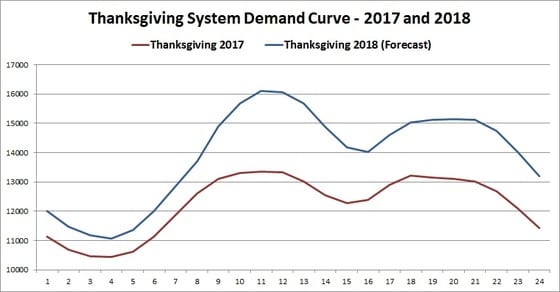As ovens heat up on Thanksgiving Day, so does electricity demand

Every year, the ISO publishes the story below on the uniqueness of the Thanksgiving Day demand curve and how electricity use coincides with oven use and TV watching. But this Thanksgiving is expected to be anything but “traditional.” Expected cold temperatures are resulting in a weather forecast that would even be daunting for a typical January. Temperatures across the region are expected to approach and/or break record cold highs and lows, dating back as far as 1901. Here’s what we’re expecting (as of Nov. 21) for electricity demand compared to what was consumed last year:

How Thanksgiving impacts the power system
For many around New England, the ritual is the same: Wake up early on Thanksgiving morning and start prepping dinner, firing up ovens for turkeys, stuffing and pies. The holiday brings a lot more activity than a typical fall Thursday morning and also changes the way ISO New England plans for the region’s energy use that day.
On most fall days, electric demand peaks in the early evening, as people around the region return home and begin household chores like laundry and cooking dinner. But on Thanksgiving, ISO New England’s system operators have seen consumer demand for electricity peak much earlier – often around noon – making it the only day of the year where electricity demand peaks this early.
ISO New England forecasters use this historical data as they build their forecasts for demand, ensuring the region has an adequate supply of electricity at any given moment—and making sure enough electricity is available during mid-day on Thanksgiving to power all of those ovens.

Follow the demand curve in real time on the ISO homepage, in ISO Express, or on our mobile app ISO to Go.
Operating the grid
One of ISO New England’s key functions is the daily reliable operation of the high-voltage power system, a six-state network of 8,600 miles of high-voltage transmission lines and more than 350 generators. To do this, the ISO works with generation and transmission companies to make sure that enough electricity is available for New England consumers at all times. In addition historical energy use on holidays, ISO Forecasters and other staff rely heavily on factors like weather as they build their demand forecasts. Temperature, dew point, precipitation, cloud cover, and wind can have a dramatic effect on consumer demand for lighting, air conditioning, and heating. Because generators are scheduled to run based on the load forecast, having accurate forecasts is imperative to ensuring that the appropriate amount of generation is online or available to meet the demand at any given second.
ISO New England wishes everyone a healthy and safe Thanksgiving!
- Categories
- Inside ISO New England
- Tags
- forecast, peak demand, system operations
